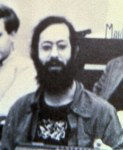| Dan Bricklin - Inventor of the PC Spreadsheet |
| Written by Historian | |||
Page 1 of 2
This was a severe problem in the early days of the personal computer because, for the computer to become truly personal, the number of computers in existence had to overtake the number of programmers! At first the solution seemed to be to make programming easy enough for anyone and there was lots of talk of vague concepts such as "computer literacy". As we all know now the solution was to remove the need to program and not to make everyone a programmer. At the time this seemed an impossibly difficult task with no obvious first step but if anything deserves the title of "first step to a programmerless world" then it is probably the spreadsheet. Dan Bricklin was the programmer in the right place at the right time to invent the now ubiquitous spreadsheet. But did it take more, a touch of genius perhaps? Dan Bricklin, born 1951 The spreadsheet is so central to the way we use computers and these days seems so obvious an idea that it hardly needs thinking up. Indeed once it was thought up by Dan Bricklin his biggest worry was that someone else would be first to the market with a real product having independently discovered the idea! Becoming a programmerDan Bricklin learned about computers in the days of mainframes and minis. He graduated from MIT in 1973, specializing in electronics and computer science. After this he followed what many programmers will recognize as a typical apprenticeship. When working at MIT he wrote a program for the Multics system, an advanced operating system, that implemented a command line calculator. Bricklin was surprised that such an advanced system lacked any way of allowing a user to work out 2 plus 2 without writing a program. Perhaps the seed of the spreadsheet idea was sown in this early observation. After spending time working on implementing advanced language systems - APL and LISP - Bricklin's apprenticeship took a turn for the practical when he joined the DEC typesetting group. As this involved a great deal of trouble shooting programming for daily newspapers trying to keep to deadlines he certainly met real users and saw how important the user interface really was! After a spell writing a word processor for a 16K 12 bit word PDP 8 minicomputer Bricklin decided it was time to go back to school - but this time to get an MBA. The reason was that after trying to get a better job an MBA seemed like the qualification he most needed. However, there was also the half formed though that it might be useful knowledge should he ever want to start his own business. Calculating for changeThe Harvard business school, where Bricklin enrolled, was famous for its case study approach. What this actually meant was that the students were expected to take data and perform long, complicated and tedious calculations. Company data was written up on lots of blackboards along with calculated values. Changing a single value usually entailed recalculating many of the results on the blackboards. Worse, a single error would propagate through the calculations and you could spend hours looking for it. As well as being a student exercise this is also the way that large companies actually did their financial planning using hoards of economists with yards of blackboards - a sort of chalk, blackboard and human precursor of the spreadsheet "what-if" facility. There is absolutely no question that the calculator, pencil and paper exercises focused Bricklin's mind on how to do the job with less sweat. Given that he was a good programmer you might think that the solution to his problem was to write BASIC to solve each assignment. The trouble with this solution was that each assignment needed a completely new program and this in itself took a long time to write. It was at this time that Bricklin conceived of an "electronic calculator, the word processor that would work with numbers". At this point Bricklin's ideas were a little hazy but they were also ambitious. He originally conceived of the grid of cells that we know recognize as a spreadsheet but he wanted to use a mouse to point at cells and manipulate values. The idea was a good one but he needed a second opinion. He asked his Harvard professors what they thought of the idea and in the main they were remarkably positive about a student's idea, apart form one who told Bricklin that there were lots of financial modeling programs and that the market was probably saturated. This may have been true, but why then were they doing what-if analysis on blackboards? Fortunately Bricklin didn't despair but the comment must have added some doubt to his plan to build the program we all needed but didn't know it. A demoThe doubting professor at least suggested that Bricklin contacted someone who might know better - Dan Flystra an ex-student who had a plan to start a software distribution company. Flystra basically told Bricklin to contact him when and if he had a product. Not discouraging but hardly the positive response that the most important idea in computer applications deserved.
Dan Flystra Bricklin decided to spend his summer vacation implementing a demo. This was written in Basic on an Apple II that Flystra made available. A few hundred lines of code animated 100 cells - if 20 seconds per recalculation can be called animation! The 10 by 10 grid fitted on the screen so there was no scrolling, no printing but it was recognizably an electronic spreadsheet complete with A, B, C for the columns and 1, 2, 3 for the rows. At first the game paddles of the Apple II were used in place of a mouse for positioning but eventually this was dropped in favor of the cursor keys. The demo was used to work out many of the important features of the interface - the slash to initiate a command and the automatic entering of cell references by pointing. <ASIN:B000BKVL8Y> <ASIN:1430210788> <ASIN:0471369462> |
|||
| Last Updated ( Friday, 21 September 2018 ) |


